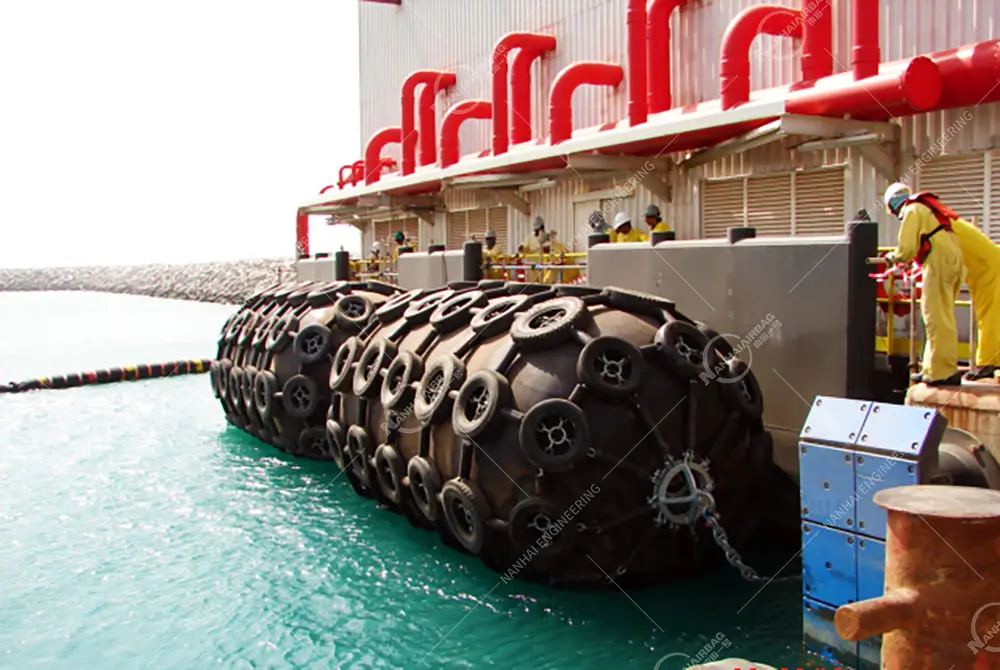What is the ship to ship operation plan?
09/23/2025Foam Fenders For Sale — Durable & Low-Maintenance Solutions for Ports
09/25/2025Why Do Pneumatic Fenders Need BV Certificate?
When you invest in pneumatic fenders, you expect them to protect ships, crews, and port structures. But not all fenders are the same. Some look similar on the outside but perform very differently in real operations. That’s why international buyers and designers often ask one key question: “Does the fender come with a BV certificate?”
BV (Bureau Veritas) is one of the most trusted classification societies in the world. Its certificate proves that the fender has passed strict third-party testing. For shipowners and port designers, this certificate is more than just paper — it’s a guarantee of safety, compliance, and long-term value.
In this guide, we explain why BV certification is important, what it covers, and what you should check before buying. We also share how NANHAI, a world-class manufacturer from China, helps clients with certified fenders and reliable after-sales support.
What Is BV (Bureau Veritas)?
Bureau Veritas, also known as BV, was founded in 1828 in France. Today it is a member of IACS (International Association of Classification Societies), which makes its certificates globally recognized.
For marine equipment such as pneumatic fenders, BV provides:
- Type Approval Certificates – confirming the design meets international standards.
- Inspection Certificates – proving that each batch has been tested before delivery.
- Factory Approvals – checking that the manufacturer has proper quality control in place.
Simply put, if a pneumatic fender has BV certification, you know it has been checked by independent experts.
What Does BV Check in Pneumatic Fenders?
BV certification is not only about a visual inspection. It involves a full process of testing and verification, including:
- Design and strength – compression tests to make sure the fender absorbs energy correctly and recovers shape.
- Material quality – rubber layers tested for ozone resistance, wear resistance, and aging.
- Pressure and airtightness – checking the internal pressure, air retention, and burst strength.
- Factory quality control – verifying that the production line follows strict procedures.
- Sample and batch testing – taking random samples for lab and on-site tests.
These steps ensure the fender you buy can perform safely for many years, even in tough environments.

Six Key Benefits for Shipowners and Port Designers
Why should you insist on BV certificates when purchasing pneumatic fenders? Here are the main reasons:
- Reliable safety – certified fenders reduce the risk of failure during berthing.
- Lower insurance disputes – insurance companies accept certified products more easily, which makes claims smoother.
- Faster port approval – many ports trust BV certificates and accept equipment without extra inspections.
- Predictable maintenance – certified fenders usually have longer service life and lower upkeep costs.
- Reduced procurement risk – certificates give you clear evidence that the product meets international standards.
- Easier design work – BV-approved performance data can be used directly in berth and mooring calculations.
How to Verify a BV Certificate
Unfortunately, fake certificates sometimes appear in the market. Here’s how you can protect yourself:
- Ask for the certificate copy – it should have a certificate number and BV logo.
- Check with BV office – contact your local BV office or use their system to confirm the number.
- Compare details – the model and batch on the certificate should match the product you are buying.
- Request recent inspection reports – not just old certificates, but up-to-date test documents.
- Look at production evidence – ask for factory photos or videos from the inspection process.
If the supplier hesitates to provide these, consider it a red flag.
Buying Checklist for Pneumatic Fenders
When you prepare to buy fenders, especially for large port or shipyard projects, keep this checklist:
- Technical manual with energy absorption curve, pressure data, and size drawings.
- BV certificate (type approval and/or inspection certificate).
- Factory batch records and traceability information.
- Warranty terms, service support, and spare parts policy.
- Clear acceptance plan: on-site inspection, size check, and pressure test at delivery.
This way, you know exactly what you are paying for and avoid hidden risks.
NANHAI’s Commitment to Quality
At NANHAI, we understand the importance of trust. As a world-leading manufacturer of pneumatic fenders from China, we provide:
- BV certificates for our products, available on request.
- Transparent testing records – including inspection reports and factory photos.
- Technical support – manuals, drawings, and calculation data for design engineers.
- Global service – quick response for installation, training, and spare parts supply.
Our goal is simple: give shipowners and port designers confidence that the fenders they install are safe, compliant, and built for long-term use.
Conclusion
BV certification is not just a formal document. It is a clear sign that your pneumatic fender has been tested for safety, durability, and quality. For shipowners and port designers, choosing BV-certified fenders means fewer risks, smoother insurance, and more reliable performance.
If you want to secure your next project with trusted fenders, NANHAI is ready to support you. Contact us today to request BV certificates, technical manuals, or a customized quotation.
FAQ
1. Does a BV certificate mean the fender will never fail?
No product lasts forever, but BV certification reduces the risk of early failure and ensures better quality control.
2. What is the difference between Type Approval and Inspection Certificate?
Type Approval confirms the design meets standards, while an Inspection Certificate applies to a specific batch or delivery.
3. Can I check the BV certificate myself?
Yes, you can verify the certificate number directly with BV offices or request official confirmation.
4. Is BV certification required by law?
Not always, but many ports, shipowners, and insurers prefer or require it.
5. What documents can NANHAI provide?
We can provide BV certificates, test reports, manuals, and installation guidance for all our pneumatic fenders.
